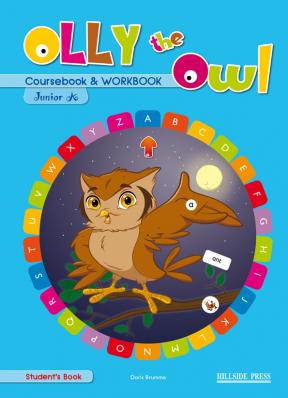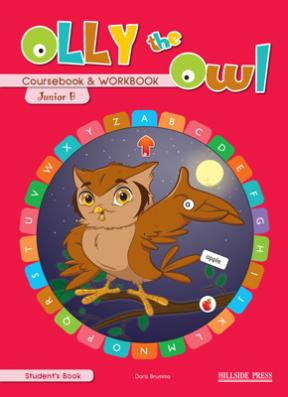Primary Courses / Olly the Owl A junior & B junior
Olly the Owl A junior
The lesson structure of Olly the Owl A junior is simple and consistent. Throughout the course, emphasis is given to listening and repeating. This is followed up with emphasis on writing and grammar.
The Pupil’s Book is made up of 30 two-page spread core lessons. The syllabus has the following structure:
- 2 introductory lessons at the beginning of the book, focusing on basic vocabulary, functional language and singing. These two lessons provide pupils with songs and easy listening and speaking activities to boost their confidence and pave the way for more concrete learning.
- 8 alphabet lessons teaching the name and sound of the letters which are represented with CVC (consonant-vowel-consonant) and three-letter words, as well as songs. These lessons teach the alphabet and introduce basic language functions, eg- the use of a/an, What’s this/that?, etc. In the alphabet section, there is a revision after every two lessons (8 letters).
- 20 theme-based lessons, introducing thematically linked vocabulary and grammar. This section of Olly for Junior A provides a clear grammar-based curriculum with parallel activities in reading, speaking, listening and writing. Age-appropriate theme-based vocabulary is introduced in every lesson. In this section, revisions appear after every four lessons.
- 3 well-known children’s stories adapted for this level. There are suggestions for pre-listening and post-listening activities, as well as games, on the corresponding teacher’s book pages.
- a 6-page fold-out section promoting cross-curricular features and social values. This section connects English to other curricular areas, promoting values such as good manners, interaction with others, etc. The fold out also offers 4 cross-curricular sections ('See the word'), giving pupils the opportunity to connect to the real world. These 4 sections provide pupils with fun projects through art/craft work.
All lessons include songs and games that help pupils practise the language focus of the lesson in a fun and creative way.
The incorporated Workbook mirrors the structure of the Coursebook. It provides more written practice with the vocabulary and grammar introduced in the Coursebook.
Olly the Owl B junior
Olly the Owl for Junior B, the third book of the three-level course, has been specifically designed for pupils who are just starting English. It makes use of a range of classroom strategies and materials that teachers know work well with young learners. The uncomplicated and consistent lesson structure will prove a powerful tool for experienced and new teachers alike. The interactive Alphabet wheel on the cover can be used as a fun way for pupils to revise the names of the letters, their sounds and the example words. Another key feature of this Junior series is that the Workbook has been incorporated into the Coursebook, so pupils have fewer books to carry or to leave behind.
The Pupil’s Book is made up of 30 core lessons. The syllabus has the following structure:
- 1 introductory lesson at the beginning of the book, revising previous knowledge; basic vocabulary, and grammar.
- 29 theme-based lessons, introducing thematically linked vocabulary and grammar
- 6 revision sections (one after every five lessons)
- 4 children’s stories adapted for this level. There are suggestions for pre-listening and post-listening activities, as well as games and activities, on the corresponding Teacher’s Book pages.
- a 6-page fold-out section that connects English to other curricular areas, promoting values such as respecting the environment, interaction with others, etc. The fold out also offers three cross-curricular sections, titled “I want to know!”, which give pupils the opportunity to connect to the real world. These three sections provide pupils with fun projects involving art/craft work.
- Songs. Each lesson includes a song to help reinforce the language focus of the lesson.
The Coursebook also includes two stickers pages. The stickers are to be used in the Coursebook, in the Revision sections. The stickers activities promote pupils’ comprehension of material taught, in a motivating and learner-friendly way.
The incorporated Workbook mirrors the structure of the Coursebook, providing further opportunity for practice. Ideally, the lessons in the Workbook should be done after those of the Coursebook, in class. Alternatively, depending on the level of your class, the Workbook pages can be completed as homework, as long as clear instructions are given.


